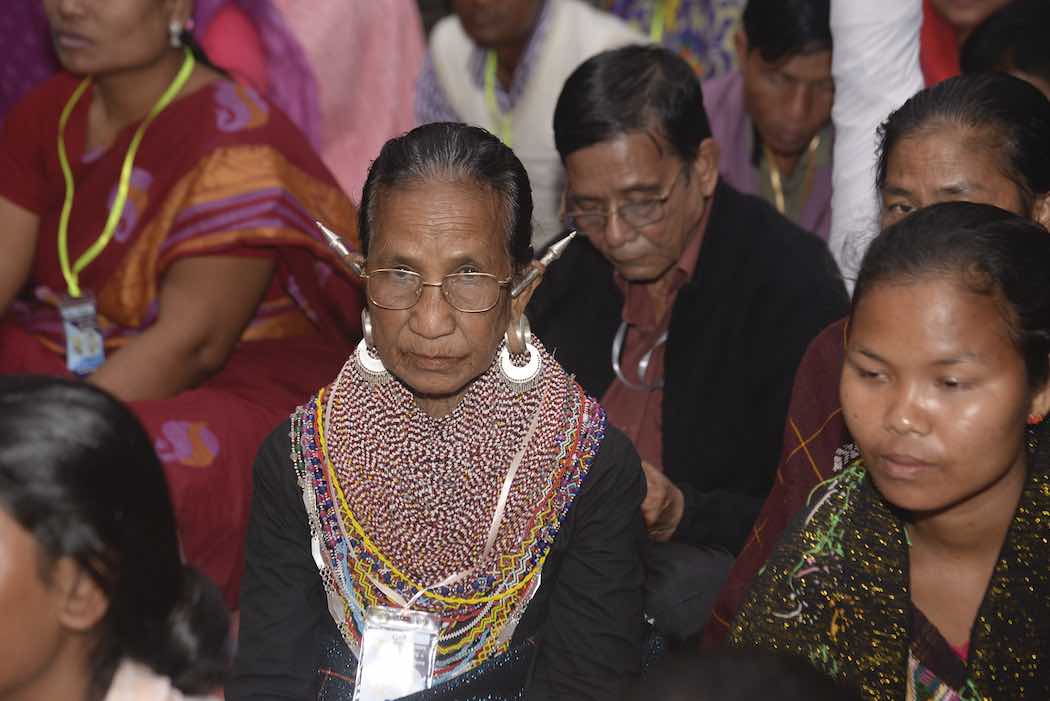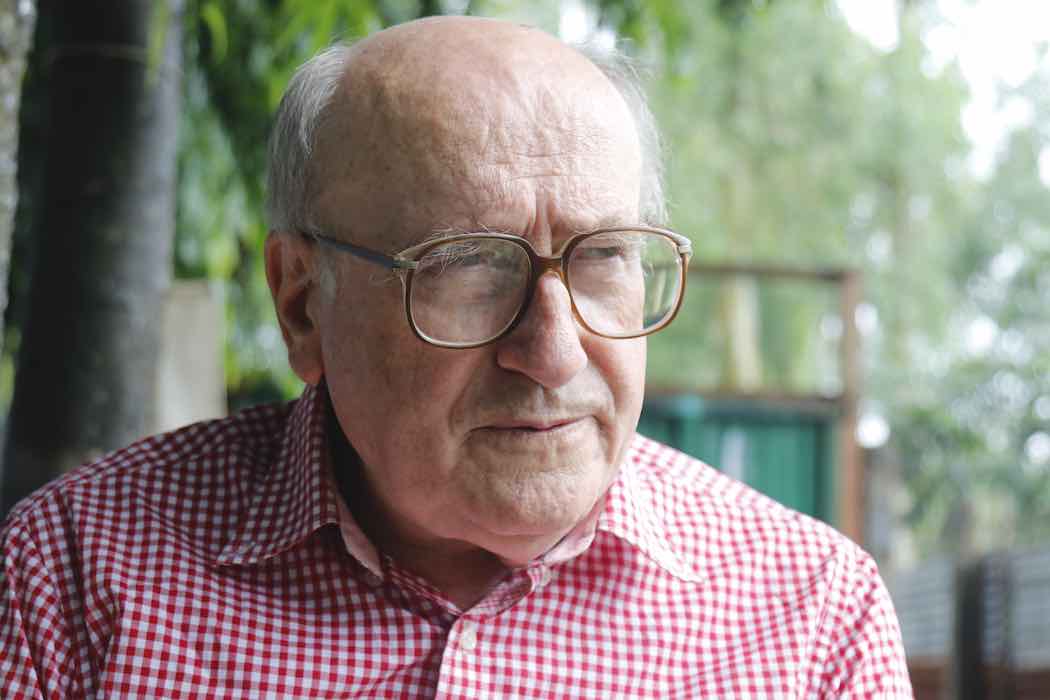

Father Paulus Murmu, an Oblate priest from the ethnic Mahali community, is seen in front of Queen Assumed into Heaven Catholic Church in Natore district of northern Bangladesh. (Photo: Stephan Uttom/UCA News)
As a five-year-old, Paulus Murmu could not have imagined a future other than becoming a cane craft worker like his parents. But today at 51, the man from the Mahali tribal community is a seasoned missioner of the Oblates congregation founded in France.
Just two months ago, he became assistant parish priest of Mary, Queen Assumed into Heaven Parish at Gopalpur of Natore district in northern Bangladesh.
Another Oblate, 64-year-old Father Subash Anthony Costa, a local Bengali priest, is the primary priest.
Western missionaries evangelized the area more than a century ago. It became Rajshahi Diocese three decades ago and is almost completely managed by local priests.
Bengali Father Costa and tribal Father Murmu reflect the change that has taken place in the Catholic missions of Bengal — local vocations have replaced overseas missioners.
Ever since his ordination as a priest in 2008, Father Murmu has been mostly stationed in mission parishes.
He said he learned lessons of frugality from his poor family at an early age. “We collected water for drinking, bathing, washing and other daily use from faraway places. We had to ensure no water was wasted,” recalled Father Murmu during a recent interview with UCA News.
His parents were cane craft workers who made household items from bamboo and sold them in markets. Their income was meager, so they always struggled to put enough food on the plates of their four children.
“The life of foreign missionaries challenges us to live with the scarcity of water, poor sanitation and impassable roads,” he said.
“Often it takes a whole day to reach some mission stations, on foot and by boat. But we have the life examples of people who have gone through that before us.”
Father Murmu says priorities involve helping young people and making weekly pastoral visits to Catholics spread in five villages, four of them at least 30 minutes ride away on his motorbike.
Just like Father Murmu’s Mahali community, the diocesan Catholics are predominantly indigenous people belonging to the Santal, Oraon and Paharia ethnic groups.
Before coming to the parish, Father Murmu worked in the high and undulating Barind region in Rajshahi in the north, the tea estate zone of Sylhet in the northeast and the mountainous, rugged terrain of Chittagong in the southeast.
His current parish has paved roads and basic facilities like piped water. Some 1,500 mostly tribal Catholics in the area were organized into this parish only some 13 years ago. They are mostly poor villagers engaged in farming and daily-wage farmwork.
Call to the mission
Father Murmu, the youngest of four siblings, wanted to become a priest as he grew up watching an Italian missionary priest who served his parish in the 1980s.
Father Emillio Spinelli, a missioner from the Pontifical Institute of Foreign Missions (PIME), was the parish priest for 25 years and supported poor ethnic students to get free education and accommodation in church-run schools and hostels.
Father Murmu’s parents couldn’t afford his education and agreed to send him to a church-run hostel. The hostel experience emboldened his religious vocation.
“I loved reading books and observed great missionary activities of PIME priests. Their family visits, cordial behavior and simple life attracted me so much that I wanted to become a priest,” Father Murmu recalled.
However, Father Spinelli discouraged him from taking up religious life and urged him to complete his education, become a teacher and support his poor family and his community. He followed his mentor’s words. He completed post-graduation and taught in a school.

Oblate Father Paulus Murmu leads the Way of the Cross with Catholics in Chittagong Hill Tracts in 2014. (Photo supplied)
Saintly inspiration
In 1995, when the missionary went home to Italy for a vacation, Father Murmu successfully completed a candidate selection program in the Bangladeshi capital Dhaka. He joined the Oblates two years later.
Father Murmu says the life of Oblate founder St. Eugene de Mazenod inspired him to join the congregation.
“There were lots of writings about him in a local Catholic weekly. Moreover, the invitation to join Oblates was very moving — if you accept this invitation, you would have nothing personal but your life would be filled with joy with Jesus. It attracted me to join the order,” the priest recalled.
For the next nine years, he studied philosophy and theology at Holy Spirit Major Seminary in Dhaka and then in Sri Lanka before he was ordained as the fifth priest from the Mahali community.
According to Joshua Project, Bangladesh is home to about 32,000 Mahali people. Almost all Mahali are Christians, mostly Catholics.
The socio-economic conditions of the Mahali community are in tatters, Father Murmu said.
“Mahali people were poor when I was a child, but they had their land and other income from selling their cane products. But the invasion of plastic products reduced the demand for bamboo and cane products,” he said.
“Nowadays, many have left their traditional jobs to become day laborers, working in the fields of others. Yet their life of faith is strong. They go to Sunday Mass and participate in parish programs actively.”

About half of the estimated 400,000 Catholics in Bangladesh hail from ethnic minority communities. Ethnic Catholics are a majority in five out of eight Catholic dioceses in the country. (Photo: Piyas Biswas)
Touching poor people's lives
Father Murmu says he feels glad to serve ethnic communities, especially those who are as poor as his own family was decades ago.
“I am happy because I have chosen this life and I find joy in touching the lives of the poor people. I feel great satisfaction every time I baptize a child and dispense sacraments to people,” he said.
Like in other parts of Rajshahi and neighboring Dinajpur Diocese, PIME missionaries played a vital role in the growth of the church in Gopalpur.
In 1904, Italian Father Santino Taveggia baptized the first ethnic Paharia from Gopalpur at a church in Kushtia, which is now part of Khulna Diocese. Father Giuseppe Macchi baptized eight tribal Catholics in Gopalpur in 1907, according to PIME records.
Father Taveggia became the first bishop when Dinajpur Diocese was created in 1927. Rajshahi was part of Dinajpur Diocese until it became a new diocese in 1990.
The legacy of missionaries, especially PIME priests, is still strongly felt, Father Murmu said.
“I try to imitate the committed and prayerful life of PIME missionaries I witnessed as a young boy. They were very social and embraced local people as their own. They hung out with boys and girls and played football with boys like us. Their legacy is simply unforgettable.”
The Oblates are among 20 international religious orders currently active in Bangladesh. The Oblate mission started in Bangladesh in 1973 with the arrival of Oblate priests from Sri Lanka. Since then, 28 local Oblate priests have been ordained including four serving in other countries as missionaries, according to senior Oblate Father Subash Costa.
Archbishop Bejoy N. D’Cruze of Dhaka is a popular Oblate priest who also served the dioceses of Khulna and Sylhet as a bishop.
Missionaries and growth of the Church
Western missionaries, especially PIME missionaries, have been an integral part of the growth of the Church in northern Bangladesh, where the Spanish Carmelite missionaries first evangelized in the 17th century.
Two PIME foreign missioners followed first Bishop Taveggia to lead Dinajpur until 1968, when Michael Rozario, a Bengali diocesan priest, became the first native bishop.
Dinajpur and Rajshahi together have some 130,000 Catholics who are predominantly tribal people from the Santal, Oraon, Mahali, Munda and Paharia tribes.
Missioners built churches, schools and hostels to educate villagers and started hospitals and social development projects to reduce endemic poverty.
Until the government inaugurated a bridge over the Jamuna River in 1998, the northern region, known as the “rice bowl” of Bangladesh, was one of the most deprived, disconnected and underdeveloped parts of the country.

Italian PIME missionaries like Father Carlo Buzzi, 78, have played a vital role in the evangelization and growth of the Catholic Church in northern Bangladesh for about a century. (Photo: Stephan Uttom/UCA News)
PIME legacy
Until five decades ago, most priests working in Rajshahi and Dinajpur dioceses were PIME missionaries. Today there are only about 13 PIME priests among the 125 priests in these dioceses.
Local and foreign priests from missionary congregations are active in Rajshahi and Dinajpur dioceses, according to church sources. There are eight Franciscan and four Holy Cross priests serving in Dinajpur. All are natives.
In Rajshahi, three foreign Salesian priests are stationed. The diocese has three local Jesuits, three Oblates and two Holy Cross priests.
The last PIME missionary came to Bangladesh in 2018, according to Italian PIME priest Father Carlo Buzzi.
Five Bangladeshi PIME priests are now serving in other countries while other missionary congregations too have seen local vocations, which is “a sign of the local Church’s growth,” he said.
Difficult mission
Catholics in Muslim-majority Bangladesh continue to be a tiny minority in spite of the dedicated service by many missionaries in the past five centuries. Christians account for 0.4 percent or roughly 600,000 people of the Muslim-majority nation’s 160 million people.
Catholics across the eight dioceses in the country are estimated to be about 400,000. About half of the Catholics hail from ethnic communities.
Church sources say priestly and religious vocations are increasingly higher among tribal Catholics while they are shrinking among Bengali Catholics.
The history of Christian mission dates back to the arrival of Portuguese Catholic merchants in 1517 at Chittagong port, which was then under the Sultanate of Bengal ruled by the Arabic Hussain Shahi dynasty.
The sultanate covered much of the Ganges–Brahmaputra plains, including the present-day Indian states of West Bengal, Odisha and Tripura, besides the Arakan area in Myanmar.

Our Lady of the Holy Rosary Cathedral Church in Chittagong of southeast Bangladesh. Catholicism first arrived in Bengal province of India with Portuguese Catholic merchants in the early 16th century. (Photo: Rock Ronald Rozario/UCA News)
Arrival of Portuguese merchants
The first Christian settlements in present-day Bangladesh came in 1518 when the second group of Portuguese merchants arrived and decided to settle in Diang and Chittagong.
Portugal granted the Bengal mission to the Augustinian order in 1599 but the first Catholic missioners to arrive were Portuguese Jesuit Fathers Francesco Fernandes and Father Dominic D’Souza. They were soon followed by more Jesuits, Dominicans and Augustinians.
In 1602, Father Fernandez became the first martyr of Bengal following his incarceration, torture, blinding and murder at the hands of soldiers of the Arakan kingdom.
The first church in what is now Bangladesh was built in 1600 by Portuguese Jesuits at Chandecan (Iswaripur) in the present-day Satkhira district.
River erosion devoured the structure centuries ago while the church land has been grabbed by local Muslims, sources say.
The Jesuits started a second church in 1601 at Chittagong while the Augustinians built their first church in Dhaka Archdiocese in the first half of the 17th century.
‘New winds are blowing’
The missionaries arriving in Bangladesh included English and Belgian Benedictines, Xaverian Fathers and Holy Cross Fathers from France, Canada and America.
But PIME missionaries have had a lasting impact on the country ever since their arrival in Jessore, southwest Bangladesh, in 1855.
Jessore was made a diocese under India’s Calcutta Archdiocese in 1952 and in 1956 it was renamed Khulna and entrusted to the St. Francis Xavier Foreign Society, popularly known as the Xaverian missionaries.
By the end of the 20th century, 45 Xaverians were working in Bangladesh — a majority of them Italian but also Mexican, Scottish, Spanish, Brazilian and Indonesian.
According to Italian Xaverian Father Luigi Paggi, fewer than 20 Xaverians are working in the country now. The last Xaverian, Father Juan Jose, a Mexican, came in 2019.

Foreign and local Holy Cross priests are seen during an annual retreat program in Chittagong in 1966. European and American missionaries are credited for the advent and growth of the Catholic Church in Bangladesh. (Photo: Chittagong Archdiocese)
Bleak future for Xaverians
Father Paggi says Xaverians have followed in the footsteps of Jesuits and Salesians who came to southern Bangladesh centuries ago and took care of Christians as well as other religious communities, mainly belonging to low-caste Hindus who were former untouchables.
“All of them were extremely poor, so along with the usual pastoral activities we tried our best to alleviate their miseries through social development projects such as schools, dispensaries and health centers, and so on. New winds have started blowing,” said the 72-year-old Xaverian, referring to native clergy leading the missions now.
But he sees a bleak future for the Xaverians in Bangladesh as the new crop of priests isn’t there.
“There are only two ways to continue the Xaverian mission in Bangladesh: either through laypeople from countries related to the Bavarians [Xaverian laypeople] or through Bangladeshi young men who could join the congregation and carry on what the bideshi (foreigners) and white-skinned fathers started,” the priest said.
Unlike them, Holy Cross missioners are happily preparing native priests to shoulder future tasks for the largest religious group in the country.
The work of Holy Cross missioners, who arrived in 1853, spans across the country involving priests, brothers and nuns. Their priest section has some 110 members, mostly natives, according to Holy Cross sources.

Christians are estimated to be 600,000 or less than half percent of more than 160 million people in Muslim-majority Bangladesh. (Photo: Chandan Robert Rebeiro)
‘Locals are ready’
The only major seminary in the country — Holy Spirit National Major Seminary in Dhaka — was opened in 1973 after the country gained independence from Pakistan. Until then, priests who worked in the area were trained mostly in India and Rome.
The number of foreign missionaries has declined and native clergy and religious are now looking after most Catholic churches in the country, says Father Dilip S. Costa, a diocesan priest and church historian.
Of the 120 Catholic parishes in Bangladesh, around 90 percent are led by native priests, according to Father Costa.
The first Bengali priest, Holy Cross Father Dominic D’Rozario, was ordained in 1928. Diocesan Father Leonard P. Rozario, who was ordained in 1977, is described as the first fruit of the Holy Spirit Major Seminary in Bangladesh.
The decline of foreign missionaries is a sad reality but the Church will continue to prosper through their great contributions, says Father Joyanto S. Gomes, president of Bangladesh Diocesan Priests’ Fraternity, the national forum of diocesan priests.
“We have received our faith in Christ from foreign missionaries and they established the Bangladesh Church. We will remain grateful to them forever,” Father Gomes told UCA News.
He said native clergy and religious are also managing the Church’s education, health care and social services. But economic sufficiency has not been achieved yet, the priest said, adding that without support from missionaries it is often very difficult for dioceses to carry on the Church’s mission.
On the flipside, religious vocations are increasing and local priests have started to go abroad to work as missionaries, Father Gomes said.

Catholics pray during the annual pilgrimage at St. Anthony of Padua Shrine in Gazipur district of Dhaka Archdiocese. Popular devotion to Mother Mary and St. Anthony is common among some 400,000 Catholics in Bangladesh. (Photo: Chandan Robert Rebeiro)
Shrinking religiosity
Back in Gopalpur Parish, Father Murmu regrets a gradual shrinking in religiosity in society and a drop in religious vocations in the Catholic Church while Western missionaries slowly disappear.
“When I was a child, I used to hear the sound of people praying at home every evening. Due to busy lives, churchgoers are dropping. When I joined the seminary, there were 65 candidates, but there are only 25 today. Families have become smaller and many parents don’t want to send their children to religious life,” he said.
“Such realities might pose great challenges in the near future. However, I still want to believe the enlightenment we have received won’t fade away.”











